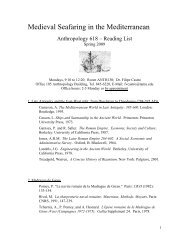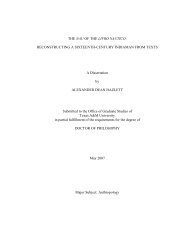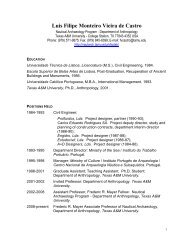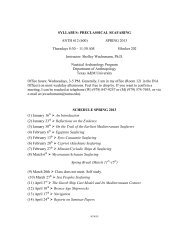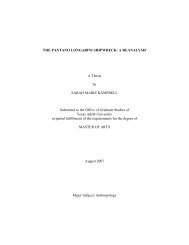- Page 1 and 2: MARBLE TRASPORT I THE TIME OF THE S
- Page 3 and 4: ABSTRACT Marble Tranport in the Tim
- Page 5 and 6: To Cesare and Gabriella Bartoli, fo
- Page 7 and 8: I am deeply indebted to Dr. Deborah
- Page 9 and 10: Artifacts: ABA Attic base BLC Block
- Page 11 and 12: Page The 2006 Mapping Season.......
- Page 13 and 14: LIST OF FIGURES Figure 1 Southern I
- Page 15 and 16: Page Figure 29 Three-dimensional di
- Page 17 and 18: LIST OF TABLES Table 1 Coordinates
- Page 19 and 20: CHAPTER I ITRODUCTIO The research t
- Page 21 and 22: to Tarentum. After locating these a
- Page 25: the Peloponnese, which sailors had
- Page 28: Calabria is 240 km long and reaches
- Page 31: It is, therefore, easy to understan
- Page 36 and 37: that which grows nearest the sea an
- Page 38 and 39: Croton and Calabria in Antiquity: S
- Page 40 and 41: Considering that Piri Reis was the
- Page 43 and 44: The islands facing Le Castella are
- Page 45 and 46: Fig. 12. Aerial view of Le Castella
- Page 47 and 48: four small shoals facing Capo Bianc
- Page 49 and 50: esettle the site, which had been ab
- Page 52: The Otranto channel is only 105 kil
- Page 55 and 56: Coming from the northeast, caught b
- Page 57 and 58: Conclusions Looking at the present-
- Page 59 and 60: CHAPTER II HISTORY OF THE STUDIES T
- Page 61 and 62: at a depth of 4 m, the massive gold
- Page 63 and 64: Thanks to a second short, yet detai
- Page 65 and 66: of antiquities and owner of the epo
- Page 67: Freschi, who carried out eight seas
- Page 70 and 71: Fig. 21. The R/V Hercules. (Photo:
- Page 73 and 74: The most important result of this f
- Page 75 and 76: Such basic gear was more than enoug
- Page 78 and 79: Table 2 provides the measurements a
- Page 80 and 81: Item # Block/Slab Length (m) Table
- Page 82 and 83: 0.11 x 0.04 m. 92 This stock repres
- Page 85 and 86:
when it hit the rocks of the promon
- Page 87 and 88:
Table 5. Dimensions and tonnage for
- Page 89 and 90:
Table 5 (continued). Tons Volume (m
- Page 91 and 92:
water, of the origin of their stone
- Page 94 and 95:
The Underwater Site During the 2006
- Page 96 and 97:
Fig. 29. Three-dimensional digital
- Page 98 and 99:
time, costing 200 denarii per Roman
- Page 100 and 101:
(MOB 8), and a lead plate represent
- Page 102 and 103:
Table 7 (continued). Current Locati
- Page 104 and 105:
Table 7 (continued). Current Locati
- Page 106 and 107:
Table 7 (continued). Current Locati
- Page 108 and 109:
Table 7 (continued). Current Locati
- Page 110 and 111:
Table 7 (continued). Current Locati
- Page 112 and 113:
understand the nature of the origin
- Page 114 and 115:
large number of these shafts were m
- Page 116 and 117:
Further parallels can be used to co
- Page 118 and 119:
The Most Diagnostic Column Shaft: C
- Page 120 and 121:
Inscriptions on Column Shafts Trans
- Page 122 and 123:
2) The following inscription is fou
- Page 124 and 125:
Table 11. Dimensions and tonnage of
- Page 126 and 127:
had on board also a mortarium, two
- Page 128 and 129:
Labra could also be used in public
- Page 130:
The Most Diagnostic Marble Basins:
- Page 133 and 134:
possible that “EL” represents t
- Page 135 and 136:
upper diameters never exceed 0.28 m
- Page 137 and 138:
Fig. 35. Bronze throne and footstoo
- Page 141 and 142:
These items from Punta Scifo A repr
- Page 143 and 144:
ands that appear at Punta Scifo wer
- Page 146 and 147:
The Statuette of Eros and Psyche, S
- Page 148 and 149:
a garden. 187 Comparison with a sim
- Page 150 and 151:
of them (MOB 3 and MOB 4) can be id
- Page 152 and 153:
Not much is known about the third a
- Page 154 and 155:
symbols for the homeowner.” 216 I
- Page 156 and 157:
façade, the six statue pedestals m
- Page 158 and 159:
complaining about the corruption of
- Page 160 and 161:
victory in Asia, he says, the statu
- Page 162 and 163:
Fig. 46. Marble tiles from the temp
- Page 164 and 165:
applications, even if on a limited
- Page 166 and 167:
Suetonius, it was Tiberius who “t
- Page 168 and 169:
Severus for instance, rebuilt his N
- Page 170 and 171:
from Thessaly represents the last b
- Page 172 and 173:
the sixth century A.D. when the aqu
- Page 174 and 175:
Pliny the Elder says that ships are
- Page 176 and 177:
Archaeological Evidence The actual
- Page 178 and 179:
Table 18. Marble wrecks discovered
- Page 180 and 181:
Table 18 (continued). Publication T
- Page 183 and 184:
Naves Lapidariae in the Mediterrane
- Page 185 and 186:
Table 21. Percentage of marble carr
- Page 187 and 188:
169 (France). 293 The Punta Scifo A
- Page 190 and 191:
From Proconnesus came three differe
- Page 192 and 193:
Magna, and Cyrene in northern Afric
- Page 194:
and statues indicates that there wa
- Page 197 and 198:
only by road, was the next most pro
- Page 199 and 200:
The merchantman, loaded with a marb
- Page 201 and 202:
absence of the four “anchoring fe
- Page 203 and 204:
Baratte, F. 1994. "Les Candélabres
- Page 205 and 206:
during the Fourth and Early Third C
- Page 207 and 208:
De Sensi Sestito, G. and M. Intrier
- Page 209 and 210:
Gianfrotta, P.A. 2005. "I Rinvenime
- Page 211 and 212:
_________. 1972. "Le Anfore del Rel
- Page 213 and 214:
Morter, J. 1992. "Capo Alfiere and
- Page 215 and 216:
__________. 2002a. "Il Fenomeno del
- Page 217 and 218:
Sabbione, C. 1984. "Le Aree di Colo
- Page 219 and 220:
201 _________, P. De Paepe, and L.
- Page 222 and 223:
LAB 2. Labrum. Present location: Ar
- Page 224 and 225:
LAB 4. Labrum. Present location: Na
- Page 226 and 227:
LAB 6. Labrum. Present location: Na
- Page 228 and 229:
HPL 1. High pedestal stand with lio
- Page 230 and 231:
HPL 2. High pedestal stand with lio
- Page 232 and 233:
HPL 3. High pedestal stand with lio
- Page 234 and 235:
HPL 4. High pedestal stand with lio
- Page 236 and 237:
HPL 6. High pedestal stand with lio
- Page 238 and 239:
220
- Page 240 and 241:
MPL 3. Medium pedestal stand with l
- Page 242 and 243:
224
- Page 244 and 245:
226
- Page 246 and 247:
The column shaft with inscription m
- Page 248 and 249:
COL 3A COL 2 230
- Page 250 and 251:
COL 4. Column shaft. Present locati
- Page 252 and 253:
COL 5. Column shaft. Present locati
- Page 254 and 255:
STP 1. Statue Pedestal. Present loc
- Page 256 and 257:
238
- Page 258 and 259:
STP 4. Statue Pedestal. Present loc
- Page 260 and 261:
242
- Page 262 and 263:
244
- Page 264 and 265:
BLC 1. Block. Present location: Cap
- Page 266 and 267:
BLC 2. Block. Present location: Cap
- Page 268 and 269:
BLC 3. Block. Present location: Cap
- Page 270 and 271:
BLC 5. Block. Present location: Cap
- Page 272 and 273:
BLC 7. Block. Present location: Las
- Page 274 and 275:
BLC 9. Block. Present location: Cor
- Page 276 and 277:
BLC 11. Block. Present location: Se
- Page 278 and 279:
BLC 13. Block. Present location: Se
- Page 280 and 281:
262
- Page 282 and 283:
ABA 1. Attic Base. Present location
- Page 284 and 285:
ABA 3. Attic Base. Present location
- Page 286 and 287:
ABA 4. Attic Base. Present location
- Page 288 and 289:
ICA 1. Ionic Capital. Present locat
- Page 290 and 291:
ICA 3. Ionic Capital. Present locat
- Page 292 and 293:
MOB 2. Mobile artifact. (Mortar). P
- Page 294 and 295:
276
- Page 296 and 297:
278
- Page 298 and 299:
280
- Page 300 and 301:
282
- Page 302 and 303:
284
- Page 304 and 305:
286
- Page 306 and 307:
288
- Page 308 and 309:
2 o .1 Basamento piccolo a sezione
- Page 310 and 311:
1. 3 Big columns and a small one, m
- Page 312 and 313:
[May 3, 1915]. English Translation.
- Page 314 and 315:
296 Aggiungasi che dato l’accatas
- Page 316 and 317:
deep into the stone, that the readi
- Page 318 and 319:
[21 giugno 1915]. R. SOPRITEDEZA AR
- Page 320 and 321:
[June 21, 1915]. English Translatio
- Page 322 and 323:
APPEDIX 3 ACIET SOURCES 304 Amm. Ma
- Page 324 and 325:
and held them chiefly to blame for
- Page 326 and 327:
308 Cod. Theod. 10.19.13: IDEM AAA.
- Page 328 and 329:
Dion. Hal. Antiquitates Romanae 20.
- Page 330 and 331:
Livy 23.30.6: Isdem ferme diebus et
- Page 332 and 333:
Livy 29.7.7: Classis Romana a Messa
- Page 334 and 335:
that it would add great beauty to t
- Page 336 and 337:
autem urbanioris notae homines sust
- Page 338 and 339:
320 Plin. H 3.11.97: A Lacinio prom
- Page 340 and 341:
his remark to them was ‘I should
- Page 342 and 343:
324 Plut. Vit. Cat. Mai. 21.5: ‘A
- Page 344 and 345:
This instruction, accompanied by co
- Page 346 and 347:
From Tarentum, Gylippus, after firs
- Page 348 and 349:
vehementissumum sidus. Et VIII kal.
- Page 350 and 351:
APPEDIX 4 DIOCLETIA’S EDICT O MAX
- Page 352 and 353:
334 Table 23. The marbles mentioned
- Page 354 and 355:
was called “Caesar” rather than
- Page 356:
VITA Dante Giuliano Bartoli Address





